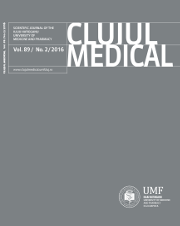Malondialdehyde can predict survival in hemodialysis patients
DOI:
https://doi.org/10.15386/cjmed-537Keywords:
oxidative stress, hemodialysis, cardiovascular disease, survival, malondialdehydeAbstract
Background and aims. Cardiovascular (CV) disease is the leading cause of morbidity and mortality in hemodialysis (HD) patients. Kidney disease is associated with increased oxidative stress (OS), a nontraditional CV risk factor. Few studies evaluate the effect of OS markers on CV events (CVE) and survival in HD patients. The aim of this study is to examine potential determinants of OS markers and their predictive role on survival and CV morbidity and mortality in HD patients during a long-term follow-up (108 months).
Methods. We conducted an analytical cross-sectional prospective observational study, carried on a cohort of randomly selected HD patients. We registered in 44 HD patients baseline characteristics, OS markers, mortality and CVE over a period of 108 months and we used statistical analysis (descriptive, Kaplan-Meier, univariate and multivariate Cox model) for interpretation.
Results. Bound malondialdehyde (bMDA) was positively correlated with serum calcium, protein carbonyls (PC) were inversely correlated with diastolic blood pressure (DBP) and directly correlated with ferritin, NOx was directly correlated with ceruloplasmin) and serum albumin. Of the measured OS markers only bMDA was related to survival (HR=3.29 95% CI (1.28-8.44), p=0.01), and approached statistical significance in the effect on CV mortality (HR=2.85 95% CI (0.88-9.22), p=0.07). None of the measured OS markers was associated with CVE.
Conclusions. bMDA has a strong predictive value on survival in HD patients in a long-term follow-up (9 years). Its value is correlated with CV mortality but is not a predictor of CV events. Regular assessment of MDA in HD patients and the development of strategies aimed at reducing oxidative stress in these patients might be beneficial.
Downloads
Published
How to Cite
Issue
Section
License
The authors are required to transfer the copyright of the published paper to the journal. This is done by agreeing to sign the Copyright Assignment Form. Whenever the case, authors are also required to send permissions to reproduce material (such as illustrations) from the copyright holder.

The papers published in the journal are licensed under a Creative Commons Attribution-NonCommercial-NoDerivatives 4.0 International License.

